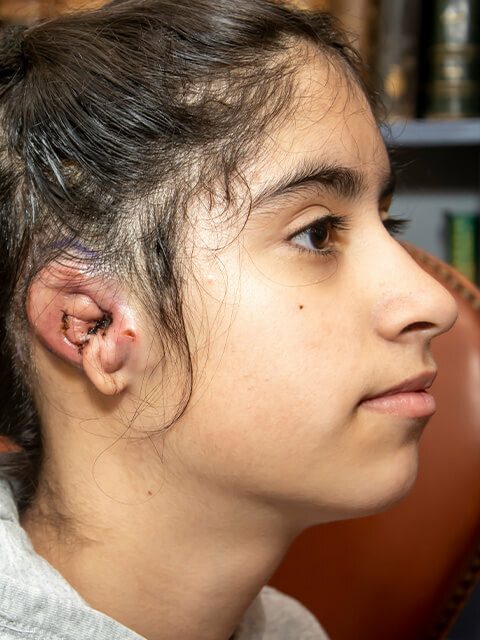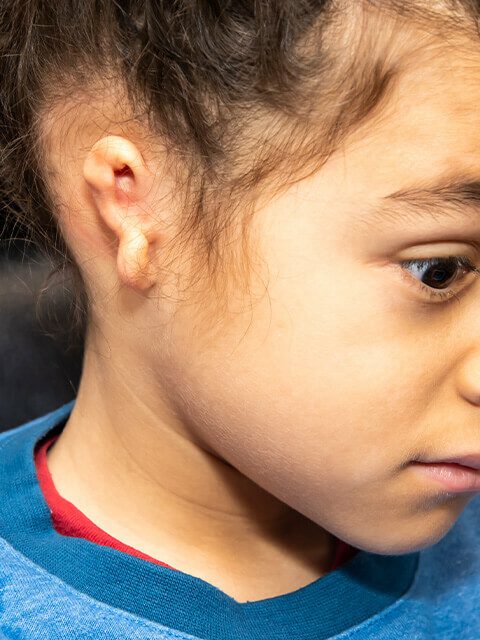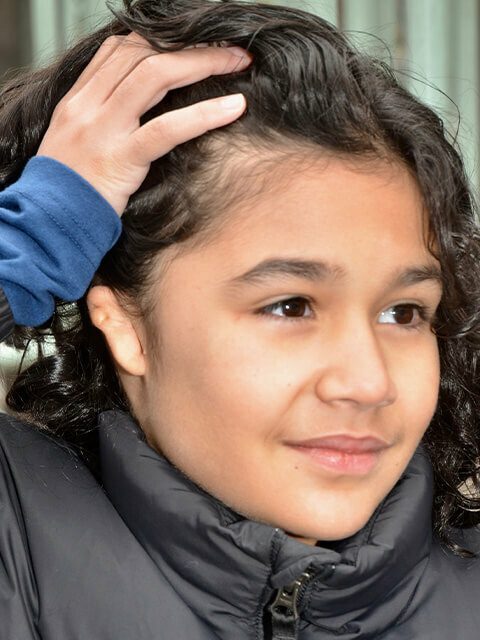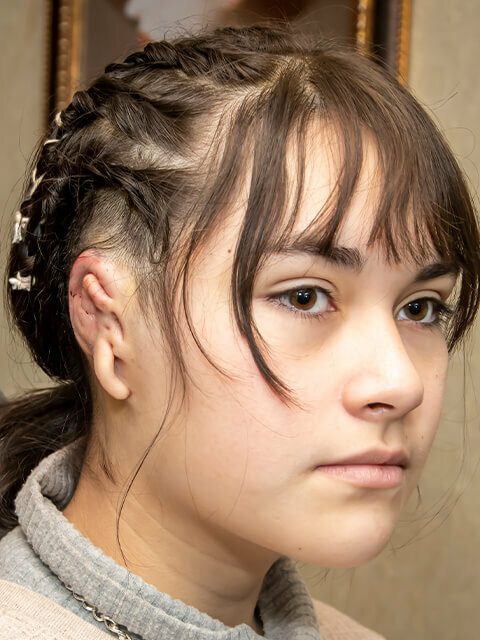
We recently implanted a bone-anchored hearing aid (BAHA) for Veronica who was born with microtia and atresia that impaired her hearing. This was her second surgery at the Little Baby Face Foundation, the first surgery having taken place in the spring of 2023 to create the framework for her ear reconstruction. Everything went smoothly, and you can read more about her most recent surgery here.

We recently implanted a bone-anchored hearing aid (BAHA) for Veronica who was born with microtia and atresia that impaired her hearing. This was her second surgery at the Little Baby Face Foundation, the first surgery having taken place in the spring of 2023 to create the framework for her ear reconstruction. Everything went smoothly, and you can read more about her most recent surgery here.
Since we have the honor to help so many children with microtia at the Little Baby Face Foundation, including Anisa from Tajikistan, Masyn from New Jersey, and Achilles from Huguenot, New York, we want to share about the extraordinary technology of a bone-anchored hearing aid. A BAHA is life-changing for children experiencing hearing loss due to microtia.
How Does a BAHA Work?
A device called a bone bridge is implanted into the bone behind the ear. The bone bridge vibrates to transmit sound directly to the inner ear, bypassing any outer skin blockages, which makes it ideal for children who have hearing loss due to microtia and/or atresia, but who do still have hearing in their inner ear.
On the outside of the skull, a magnet is paired to the implanted bone bridge containing a microphone and a battery. This is simultaneously the power source and the sound source for the BAHA.
A doctor will assess the child’s hearing in order to find the best everyday settings for the BAHA. The processor on the outside is constantly analyzing the environment to adapt accordingly, so much of the process is automatic, but there is also an app to adjust the sound input as needed, whether it’s to lower loud sounds such as sirens, or to boost soft sounds.
The implanted bone bridge will work for a lifetime with no maintenance necessary. The exterior magnet needs to be replaced every 4 years, and will have regular software updates to keep up with the latest technological advancements. We manage all of the replacements and maintenance for all of the children we care for at the Little Baby Face Foundation until they reach 21 years of age. This is an important part of keeping them hearing as well as possible.
Diverse magnet strengths are included to customize the comfort of the BAHA and tailor it to the child’s needs. For example, the child may switch to a stronger magnet when participating in sports.
The BAHA is truly an amazing device. It produces a better sound quality than most traditional hearing aids, and it consumes less energy. It is also very comfortable. However, it cannot get wet, so it’s important to remember to remove the outer magnet before swimming or showering and to wear protective gear in the rain. It is possible to wear over-the-ear headphones with a BAHA.
We are excited to be able to help so many children hear better with a BAHA. We have seen just how transformational it is for these kids and their families.
How Does a BAHA Work?
A device called a bone bridge is implanted into the bone behind the ear. The bone bridge vibrates to transmit sound directly to the inner ear, bypassing any outer skin blockages, which makes it ideal for children who have hearing loss due to microtia and/or atresia, but who do still have hearing in their inner ear.
On the outside of the skull, a magnet is paired to the implanted bone bridge containing a microphone and a battery. This is simultaneously the power source and the sound source for the BAHA.
A doctor will assess the child’s hearing in order to find the best everyday settings for the BAHA. The processor on the outside is constantly analyzing the environment to adapt accordingly, so much of the process is automatic, but there is also an app to adjust the sound input as needed, whether it’s to lower loud sounds such as sirens, or to boost soft sounds.
The implanted bone bridge will work for a lifetime with no maintenance necessary. The exterior magnet needs to be replaced every 4 years, and will have regular software updates to keep up with the latest technological advancements. We manage all of the replacements and maintenance for all of the children we care for at the Little Baby Face Foundation until they reach 21 years of age. This is an important part of keeping them hearing as well as possible.
Diverse magnet strengths are included to customize the comfort of the BAHA and tailor it to the child’s needs. For example, the child may switch to a stronger magnet when participating in sports.
The BAHA is truly an amazing device. It produces a better sound quality than most traditional hearing aids, and it consumes less energy. It is also very comfortable. However, it cannot get wet, so it’s important to remember to remove the outer magnet before swimming or showering and to wear protective gear in the rain. It is possible to wear over-the-ear headphones with a BAHA.
We are excited to be able to help so many children hear better with a BAHA. We have seen just how transformational it is for these kids and their families.
Since we have the honor to help so many children with microtia at the Little Baby Face Foundation, including Anisa from Tajikistan, Masyn from New Jersey, and Achilles from Huguenot, New York, we want to share about the extraordinary technology of a bone-anchored hearing aid. A BAHA is life changing for children experiencing hearing loss due to microtia.
How Does a BAHA Work?
A device called a bone bridge is implanted into the bone behind the ear. The bone bridge vibrates to transmit sound directly to the inner ear, bypassing any outer skin blockages, which makes it ideal for children who have hearing loss due to microtia and/or atresia, but who do still have hearing in their inner ear.
On the outside of the skull, a magnet is paired to the implanted bone bridge containing a microphone and a battery. This is simultaneously the power source and the sound source for the BAHA.
A doctor will assess the child’s hearing in order to find the best everyday settings for the BAHA. The processor on the outside is constantly analyzing the environment to adapt accordingly, so much of the process is automatic, but there is also an app to adjust the sound input as needed, whether it’s to lower loud sounds such as sirens, or to boost soft sounds.
The implanted bone bridge will work for a lifetime with no maintenance necessary. The exterior magnet needs to be replaced every 4 years, and will have regular software updates to keep up with the latest technological advancements. We manage all of the replacements and maintenance for all of the children we care for at the Little Baby Face Foundation until they reach 21 years of age. This is an important part of keeping them hearing as well as possible.
Diverse magnet strengths are included to customize the comfort of the BAHA and tailor it to the child’s needs. For example, the child may switch to a stronger magnet when participating in sports.
The BAHA is truly an amazing device. It produces a better sound quality than most traditional hearing aids, and it consumes less energy. It is also very comfortable. However, it cannot get wet, so it’s important to remember to remove the outer magnet before swimming or showering and to wear protective gear in the rain. It is possible to wear over-the-ear headphones with a BAHA.
We are excited to be able to help so many children hear better with a BAHA. We have seen just how transformational it is for these kids and their families.
How Does a BAHA Work?
A device called a bone bridge is implanted into the bone behind the ear. The bone bridge vibrates to transmit sound directly to the inner ear, bypassing any outer skin blockages, which makes it ideal for children who have hearing loss due to microtia and/or atresia, but who do still have hearing in their inner ear.
On the outside of the skull, a magnet is paired to the implanted bone bridge containing a microphone and a battery. This is simultaneously the power source and the sound source for the BAHA.
A doctor will assess the child’s hearing in order to find the best everyday settings for the BAHA. The processor on the outside is constantly analyzing the environment to adapt accordingly, so much of the process is automatic, but there is also an app to adjust the sound input as needed, whether it’s to lower loud sounds such as sirens, or to boost soft sounds.
The implanted bone bridge will work for a lifetime with no maintenance necessary. The exterior magnet needs to be replaced every 4 years, and will have regular software updates to keep up with the latest technological advancements. We manage all of the replacements and maintenance for all of the children we care for at the Little Baby Face Foundation until they reach 21 years of age. This is an important part of keeping them hearing as well as possible.
Diverse magnet strengths are included to customize the comfort of the BAHA and tailor it to the child’s needs. For example, the child may switch to a stronger magnet when participating in sports.
The BAHA is truly an amazing device. It produces a better sound quality than most traditional hearing aids, and it consumes less energy. It is also very comfortable. However, it cannot get wet, so it’s important to remember to remove the outer magnet before swimming or showering and to wear protective gear in the rain. It is possible to wear over-the-ear headphones with a BAHA.
We are excited to be able to help so many children hear better with a BAHA. We have seen just how transformational it is for these kids and their families.
Since we have the honor to help so many children with microtia at the Little Baby Face Foundation, including Anisa from Tajikistan, Masyn from New Jersey, and Achilles from Huguenot, New York, we want to share about the extraordinary technology of a bone-anchored hearing aid. A BAHA is life changing for children experiencing hearing loss due to microtia.
How Does a BAHA Work?
A device called a bone bridge is implanted into the bone behind the ear. The bone bridge vibrates to transmit sound directly to the inner ear, bypassing any outer skin blockages, which makes it ideal for children who have hearing loss due to microtia and/or atresia, but who do still have hearing in their inner ear.
On the outside of the skull, a magnet is paired to the implanted bone bridge containing a microphone and a battery. This is simultaneously the power source and the sound source for the BAHA.
A doctor will assess the child’s hearing in order to find the best everyday settings for the BAHA. The processor on the outside is constantly analyzing the environment to adapt accordingly, so much of the process is automatic, but there is also an app to adjust the sound input as needed, whether it’s to lower loud sounds such as sirens, or to boost soft sounds.
The implanted bone bridge will work for a lifetime with no maintenance necessary. The exterior magnet needs to be replaced every 4 years, and will have regular software updates to keep up with the latest technological advancements. We manage all of the replacements and maintenance for all of the children we care for at the Little Baby Face Foundation until they reach 21 years of age. This is an important part of keeping them hearing as well as possible.
Diverse magnet strengths are included to customize the comfort of the BAHA and tailor it to the child’s needs. For example, the child may switch to a stronger magnet when participating in sports.
The BAHA is truly an amazing device. It produces a better sound quality than most traditional hearing aids, and it consumes less energy. It is also very comfortable. However, it cannot get wet, so it’s important to remember to remove the outer magnet before swimming or showering and to wear protective gear in the rain. It is possible to wear over-the-ear headphones with a BAHA.
We are excited to be able to help so many children hear better with a BAHA. We have seen just how transformational it is for these kids and their families.
How Does a BAHA Work?
A device called a bone bridge is implanted into the bone behind the ear. The bone bridge vibrates to transmit sound directly to the inner ear, bypassing any outer skin blockages, which makes it ideal for children who have hearing loss due to microtia and/or atresia, but who do still have hearing in their inner ear.
On the outside of the skull, a magnet is paired to the implanted bone bridge containing a microphone and a battery. This is simultaneously the power source and the sound source for the BAHA.
A doctor will assess the child’s hearing in order to find the best everyday settings for the BAHA. The processor on the outside is constantly analyzing the environment to adapt accordingly, so much of the process is automatic, but there is also an app to adjust the sound input as needed, whether it’s to lower loud sounds such as sirens, or to boost soft sounds.
The implanted bone bridge will work for a lifetime with no maintenance necessary. The exterior magnet needs to be replaced every 4 years, and will have regular software updates to keep up with the latest technological advancements. We manage all of the replacements and maintenance for all of the children we care for at the Little Baby Face Foundation until they reach 21 years of age. This is an important part of keeping them hearing as well as possible.
Diverse magnet strengths are included to customize the comfort of the BAHA and tailor it to the child’s needs. For example, the child may switch to a stronger magnet when participating in sports.
The BAHA is truly an amazing device. It produces a better sound quality than most traditional hearing aids, and it consumes less energy. It is also very comfortable. However, it cannot get wet, so it’s important to remember to remove the outer magnet before swimming or showering and to wear protective gear in the rain. It is possible to wear over-the-ear headphones with a BAHA.
We are excited to be able to help so many children hear better with a BAHA. We have seen just how transformational it is for these kids and their families.
If your child was born with Microtia and you’re looking for help, please contact us using the form below.
If your child was born with Microtia and you’re looking for help, please contact us using the form below.





